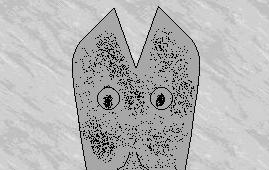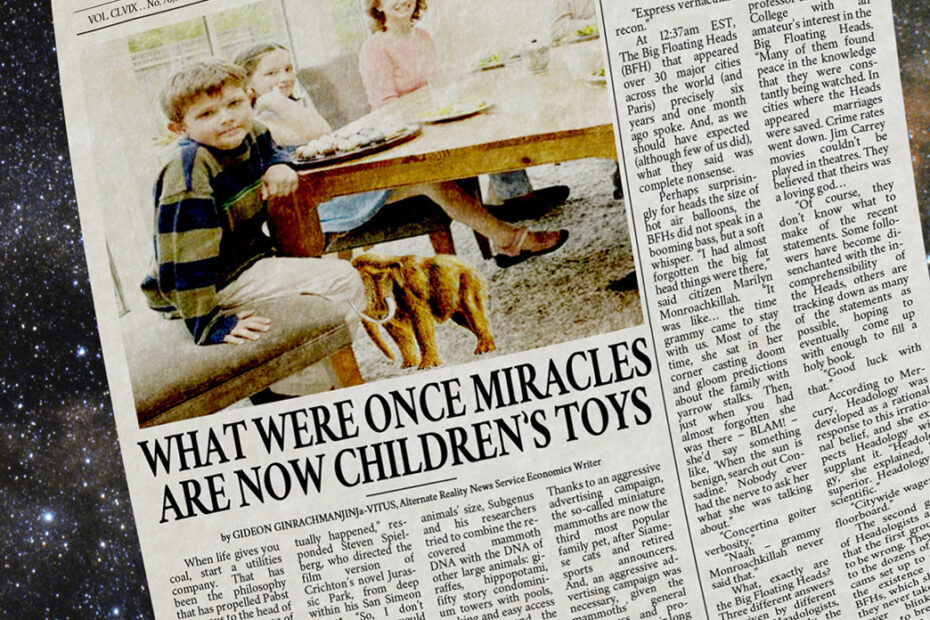by FRED CHARUNDER-MACHARRUNDEIRA, Alternate Reality News Service Science Writer
Bonita Verklempt wanted an animal that had the power of a horse. Gerald McFlecktone wanted an animal with the grace of a cat. Arnold “Just Arnold” Compote wanted an animal with the nose of an anteater. What they got was an animal with the excretions of a horse, the skittish temperament of a cat…and the nose of an anteater.
What they got was a flutz.
About the size of the OED, the common flutz has the body of a raccoon which appears to have been put through a blender, an outsized head, four eyes (two on its head and one on each of its tails), human hands on two of its four legs and the underhanded cunning (not to mention IQ) of a Rush Limbaugh dittohead. The rare pink-nosed flutz is so disgusting we’d have to password protect our site just to describe it.
“I thought the hands would be useful for the flutz because it could use them to pass researchers the medical equipment they needed to experiment on it,” McFlecktone ruefully stated. “Instead, it mostly uses them to scratch its bum and make rude gestures at us! I can’t imagine where it learned those!”
Verklempt, McFlecktone and Compote are members of the Next Stallion Working Committee of International BioScienTech, a wholly owned subsidiary of MultiNatCorp.
“Horses are amazingly useful animals,” Verklempt stated. “You can ride them. They can pull plows or carts. They star in western movies. You can use them to count when you don’t have an abacus handy. In bad economic times, they make a tasty burger. Our committee was tasked with finding a new animal with the same or greater versatility.”
When it was pointed out that task is a noun, not a verb, Verklempt responded, “Obviously, you know nothing of the scientific method.”
By combining genetic material from different animals, International BioScienTech has become a world leader in creating new species. It’s sort of like mixing a cocktail, only with meat instead of alcohol. Lots and lots of meat.
The Next Stallion Working Committee was given the task (I do so know the scientific method – I slept with it on and off for four years!) of creating an animal that could be used in a wide range of medical experiments. “We thought we would be getting a mouse with the digestive tract of a giraffe and the spleen of a black widow spider,” explained International BioScienTech President Guy Flighty. “Now, that would have been an animal you could experiment on!
“Instead, we got…this.”
The flutz was named after the co-chairs of the Next Stallion Working Committee, Gordie Fleetermauss and Gerhardt Pavel Utz. Neither of them has been seen in public since news of the creature’s creation was first reported. Utz is rumoured to be taking a walking tour of Hawaiian volcanoes.
“The mottled and folded skin – like a flakey shar pei – was supposed to help in developing certain kinds of cancer,” Compote defended the committee’s creation, although he conveniently couldn’t remember whose idea the skin design was. “And, it probably would have, too, if any researchers had been brave enough to actually experiment on the flutz, even though it did make the animal next to impossible to clean.”
Although it is a bust in terms of medical research, International BioScienTech is looking for other ways to exploit the flutz. Owing to the unfortunate decision to give the animal the teeth of piranhas, marketing it as children’s toy is a no go. The unfortunate tendency of the flutz to defecate often and in awkward places (playpens, pianos, luggage that you thought had been safely put away in the closet until your next family vacation) made it an unlikely candidate for family pet.
The obvious next step (the next time you see the scientific method, tell it I want my mix tapes back – I put a lot of thought into what I was going to put on those tapes, and I want to give them to somebody who will appreciate them!) is to declare the flutz a failure and move on to the company’s next project. However, after eight years and a rumoured expenditure of over $10 million, that seems unlikely.
Could the dozen or so prototype flutzes be headed for a zoo near you?


